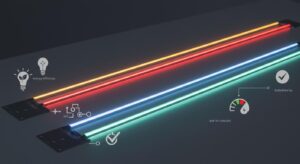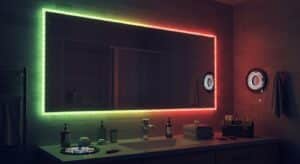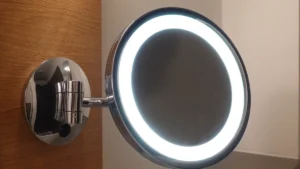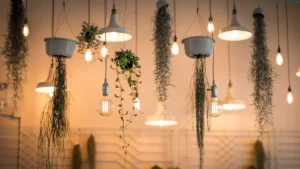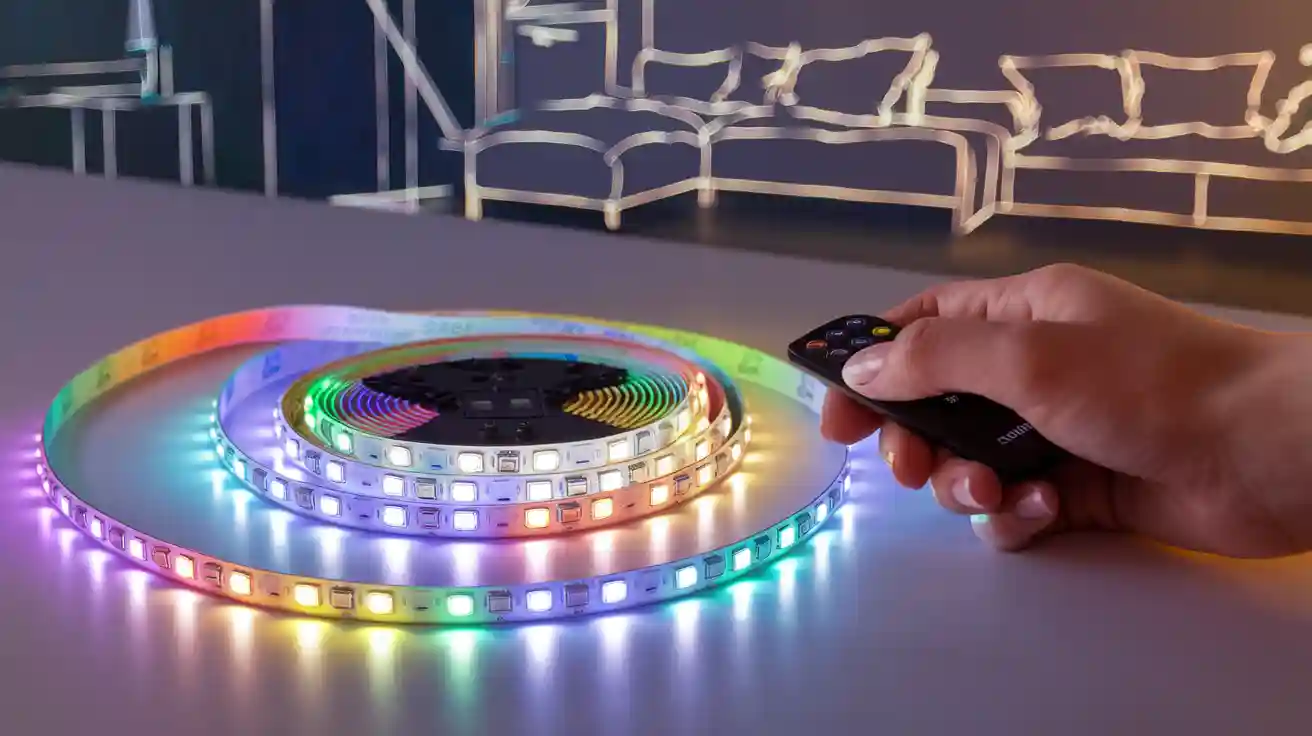
Full spectrum LED strips give light similar to natural daylight. These strips show all visible colours, giving bright and balanced light. They help improve colour accuracy and make spaces feel cosy. You can use them for home designs or work projects.
Picking the right full spectrum LED strip is very important. Things like brightness, colour quality, and how to install them matter a lot. Knowing what you need helps you choose one that works well and lasts long.
Key Takeaways
Full spectrum LED strips copy natural daylight. They improve colour accuracy and make spaces feel warm and inviting.
Look at brightness and Colour Rendering Index (CRI) when picking LED strips. A CRI of 95 or higher shows colours correctly.
Choose LED strips based on your needs, like home design, work areas, or helping plants grow. This gives the best results.
Check if the strips are waterproof and strong, especially for outside use. IP ratings show how well they handle water and dust.
Make sure the power supply works with your LED strips. This keeps them safe and running well.
What Are Full Spectrum LED Strips?
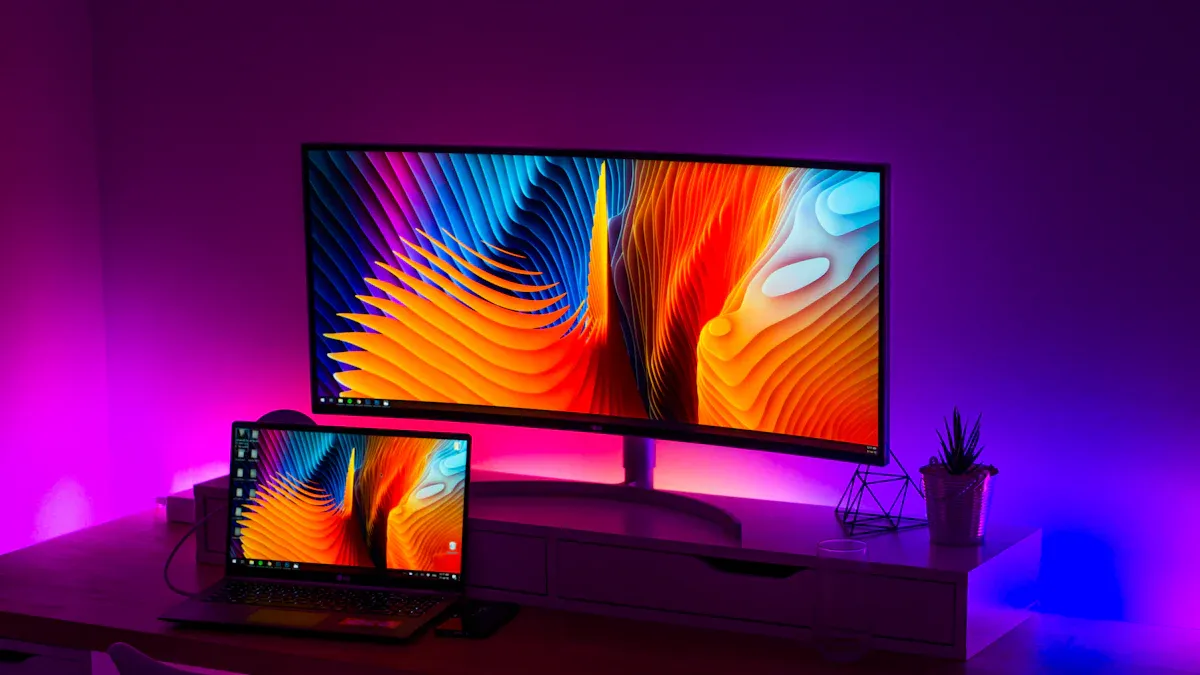
Definition and how they mimic natural light
Full spectrum LED strips copy the look of natural daylight. They give off light covering all visible colours evenly. Unlike older lights, they don’t focus on just some colours. These strips make spaces brighter and more natural-looking. They are great for places needing true colour accuracy. Use them to light up work areas or make your home look better.
Key features, including CRI, colour rendering, and light quality
Knowing the features of full spectrum LED strips is important. One key feature is the Colour Rendering Index (CRI). CRI shows how well colours look under a light. A score of 100 means colours look like they do in daylight. High CRI, usually 95 or more, makes colours look clear and correct. This is useful for art, photos, or tasks needing exact colours.
Another feature is colour rendering, which balances light output. This makes objects and spaces look better. The light quality is also high, giving bright yet soft lighting. It helps reduce eye strain and improves focus. Studies show this lighting boosts mood and helps people work better.
Benefits of using full spectrum LED strips for various applications
Full spectrum LED strips work well in many places. At home, they create a cosy and welcoming feel. They’re perfect for living rooms, kitchens, and bedrooms. In workspaces, they give clear light for detailed jobs like reading or crafting. Artists and photographers love their high CRI for true colour in their work.
Shops and offices use these strips to make products look colourful and appealing. They’re also helpful for growing plants indoors by copying sunlight. These LED strips are flexible and fit many needs, making them a smart choice for lighting setups.
Key Factors to Think About When Picking Full Spectrum LED Strips
Purpose and Use
Before choosing a full spectrum LED strip, know its purpose. Do you want to brighten your home, improve work lighting, or create a design? Each use needs different features. For example, plant-growing LED strips copy sunlight to help plants grow. These strips give the right light and save energy. High-CRI LED strips are great for art or photos, showing colours clearly.
Think about where you’ll put the LED strip. Outdoor strips need to be waterproof with high IP ratings to handle water and dust. Indoor strips, like for under cabinets or accents, don’t need waterproofing. But they should still be easy to install and flexible.
Tip: Match the LED strip’s features to your needs for the best results.
Brightness, Lumens, and Colour Accuracy
Brightness is key to how well LED strips work. Lumens show how much light is given off. CRI tells how true colours look under the light. A CRI above 95 shows colours clearly, which is great for detailed tasks.
Here’s a simple table to explain light units:
Light Unit | What It Means |
|---|---|
Lumen | Total light from a point source. |
Candela | Measures light strength in a specific direction. |
Steradian | Angle of light covering an area on a sphere. |
To find lumens:
Step 1: Get the LED’s solid angle.
Step 2: Use this formula: f = Iv * w. Here, f is light output, Iv is light strength, and w is the angle.
Colour quality depends on light wavelengths. CIE standards check visible light for accuracy. This matters for things like photography, where colours must look right.
Size, Flexibility, and Setup
The size and bendability of LED strips affect where they fit. Strips are thin, often 8mm wide and 3mm high, so they fit small spaces. You can cut them at marked spots to make them the right length.
Installing them is simple. Most strips have sticky backs to attach to surfaces. For temporary setups, use masking tape to test placement first. Here’s a quick guide:
Factor | Details |
|---|---|
Size | Thin strips fit small or tight areas. |
Flexibility | Cut at marks to fit your design. |
Easy Setup | Sticky backs make installation simple; masking tape helps test spots. |
Note: Installing correctly makes LED strips last longer. Follow the maker’s instructions for the best outcome.
Waterproofing, IP Ratings, and Durability
When picking full spectrum LED strips, waterproofing and durability are important. This matters for outdoor or wet places. Waterproof LED strips have IP ratings that show how well they resist water and dust. These ratings help you know if the strips can handle certain conditions.
The IP rating has two numbers. The first shows protection against dust. The second shows water resistance. For example:
IP65: Resists water jets, good for outdoor use but not underwater.
IP67: Handles short underwater dips, great for heavy rain areas.
IP68: Fully waterproof, works underwater up to 3 metres, ideal for ponds.
Here’s a simple table for IP ratings:
IP Rating | Description | Suitable Use |
|---|---|---|
IP65 | Resists water jets from any angle. | Outdoor use, not underwater. |
IP67 | Handles temporary submersion. | Heavy rain areas, not long underwater. |
IP68 | Fully waterproof, up to 3 metres deep. | Ponds or fountains. |
Tip: Match the IP rating to your needs. Use IP65 for outdoor lights. Choose IP68 for underwater setups.
Durability depends on the materials used. Silicone coatings protect strips from damage. Strong materials make strips last longer, even in tough conditions.
Voltage, Wattage, and Power Supply Compatibility
Voltage and wattage affect how LED strips work. Most strips use low voltage like 5V, 12V, or 24V. Picking the right voltage keeps them safe and efficient. Wrong voltage can harm the strips or shorten their life.
Wattage shows how much power the strips use. Add up the total wattage of your setup to match the power supply. For example, a 5-metre strip using 10 watts per metre needs a power supply of at least 50 watts.
Here’s a table comparing power use for popular LED strip models:
LED Strip Model | Voltage | Baseline Power Consumption | Full Brightness Power Consumption |
|---|---|---|---|
WS2811 | 5V/12V | 1.27 watts | 19.68 watts |
WS2812B | 5V | 0.56 watts | 13.6 watts |
WS2815 | 12V | 3.52 watts | 20.18 watts |
SK6812 | 5V | 0.83 watts | 10 watts |

Note: Pick a power supply with more wattage than needed. This avoids overloading and keeps performance steady.
Some LED strips need constant voltage, while others need constant current. Check the maker’s details to avoid mismatched parts.
By knowing voltage, wattage, and power supply needs, you can make your LED strips work better and last longer.
Types of Full Spectrum LED Strips

COB (Chip on Board) LED strips for smooth lighting
COB LED strips give even and smooth light. Unlike older LED strips, COB puts many LED chips close together. This design removes gaps between lights, creating a steady glow. There are no dark spots, making them great for tasks or accents in homes or offices.
COB LED strips work better than SMD (Surface-Mounted Device) LED strips. Here’s a simple comparison:
Test Type | COB LED Strips | SMD LED Strips |
|---|---|---|
Brightness Output | 1,500 lumens (10W) | 1,000 – 1,200 lumens (10W) |
Energy Efficiency | 150 lm/W (better than Energy Star) | N/A |
Brightness Retention | 90% after 30,000 hours | 70% after 30,000 hours |
Operating Temperature | 45°C | 68°C |
Light Uniformity | No dark spots | Visible light gaps |
These strips save energy and stay bright for years, giving reliable light.
RGBW (Red, Green, Blue, White) LED strips for colourful lighting
RGBW LED strips mix bright RGB colours with white light. The extra white diode makes colours clearer and adds natural light. These strips are great for parties or cosy evenings. They let you switch between fun and calm lighting.
Why RGBW LED strips are special:
They create bright colours for lively events or parties.
The white light improves colour clarity and gives soft lighting.
They work well for both decoration and practical lighting.
If you want fun effects and good light quality, these strips are ideal.
Addressable LED strips for creative lighting designs
Addressable LED strips allow full control of each light. Each LED has its own chip, so you can adjust them separately. You can make animations, colour fades, or patterns that move together.
Main features of addressable LED strips:
Control each LED for exact colours and brightness.
Use advanced systems like SPI or DMX512 for programming.
Built-in circuits (ICs) create detailed lighting effects.
These strips are perfect for art, displays, or fun projects. You can use software to design effects, making them popular with artists and hobbyists.
High-CRI LED strips for accurate colour rendering in photography or art.
High-CRI LED strips are great for showing true colours. They are perfect for photography, art, and tasks needing exact lighting. “High CRI” means a Colour Rendering Index over 90. This ensures colours look natural, like under sunlight. These strips are ideal for capturing real images or displaying art beautifully.
Here’s how their accuracy is measured:
Measurement Type | Description |
|---|---|
CRI | Shows how well light displays colours using 8 samples. |
Fidelity Index (TM-30) | Checks colour accuracy with 99 samples. |
Gamut Index (TM-30) | Measures colour brightness and depth. |
Colour Vector Graphic | Studies colour shifts and saturation across 16 bins. |
CQS | Compares colour clarity and human preference using 15 colours. |
High-CRI LED strips make colours bright and accurate. They are useful in galleries, shops, and studios. These strips stop colour changes, keeping work consistent everywhere. For photographers, they give even light, avoiding harsh shadows. This helps create high-quality photos.
Tip: Choose LED strips with a CRI of 95 or more for the best results.
Horticultural LED strips for plant growth and indoor gardening.
Horticultural LED strips are changing indoor gardening. These strips copy sunlight by giving plants the right light. Unlike old grow lights, they let you adjust the light for different plants. This makes growing plants easier and better.
Studies show how light affects plants. Blue light helps leaves grow, while red light helps flowers and fruits. By mixing these lights, horticultural LED strips create the best setting for plants. They are great for growing herbs, vegetables, or flowers indoors.
These strips save energy and stay cool, so plants don’t get damaged. You can use them in small spaces like shelves or vertical gardens. They also last long and work well in humid areas.
Note: Place the LED strips close to plants. Change the light based on the plant’s growth stage.
How to Verify Quality
Checking certifications and compliance with standards
Certifications show if LED strips are safe and high-quality. They prove the product meets important rules for performance. Look for labels from trusted organisations before buying. Here’s a simple table of key certifications:
Certification Body | What It Ensures |
|---|---|
CB | Meets global safety and performance rules. |
ETL | Follows industry safety and performance standards. |
FCC | Passes tests for electromagnetic interference. |
Energy Star | Promotes energy-saving and eco-friendly products. |
CSA | Meets safety rules in North America. |
VDE | Follows safety and quality rules in Europe. |
BS | Certifies safety and quality in the UK. |
Tip: Check packaging or product details for these certifications. They help you pick safe and reliable LED strips.
Importance of warranties and customer reviews
Warranties and reviews help you know if LED strips are dependable. A warranty shows the maker trusts their product. It also protects you if something goes wrong. For example, warranty details can reveal common problems and save money later.
Customer reviews are also helpful. They share real experiences about brightness, colour accuracy, and durability. Look for reviews that praise steady light and long-lasting use. Avoid products with complaints about flickering or overheating. Combining warranty info with reviews helps you choose LED strips that work well and last long.
Identifying reputable brands and suppliers for reliable LED strips
Picking a good brand or supplier ensures high-quality LED strips. Follow these steps to find trustworthy options:
Choose brands that focus on making LED strips.
Look for certifications like Energy Star or VDE.
Check if the supplier can handle big orders reliably.
See if they offer custom options for colours and controls.
Make sure they test products for quality.
Understand their warranty and replacement policies.
Test samples to check the product’s quality.
Compare prices and payment terms for the best deal.
Build strong relationships with suppliers who deliver good products.
By following these tips, you can find LED strips that suit your needs and last a long time.
Common Mistakes to Avoid
Picking the wrong brightness, lumens, or colour temperature
Choosing the wrong brightness or colour temperature can ruin lighting. You might not realise how much light your room needs. Dark walls and ceilings soak up more light. Medium-dark surfaces may need twice the lumens, while very dark ones might need four times more. Adding 10–20% extra light can help if you like brighter spaces. Skipping these steps often leads to dim or uneven lighting.
Colour temperature is also very important. Warm tones (2700K–3000K) feel cosy, while cool tones (4000K–5000K) work better for tasks. Picking the wrong tone can make a room feel odd or unhelpful. Always match the light to the room’s purpose.
Tip: Try different brightness and colour tones before choosing your LED strips.
Forgetting power supply compatibility and voltage needs
Using the wrong power supply is a common mistake with LED strips. For example, a 12V power supply won’t work with a 24V strip. Always check that the power supply matches your LED strip’s voltage and current. A multimeter can help you check the voltage output for accuracy.
Loose wires or short circuits during setup can also cause problems. Check all connections carefully. Bad soldering can lead to power loss or damage the strips. Using the right power supply improves performance and makes your LED strips last longer.
Skipping installation needs, waterproofing, or durability
Bad installation or ignoring waterproofing can cause big problems. For outdoor or wet areas, use waterproof LED strips with the right IP rating. For example, IP65 strips handle water jets, while IP68 strips can go underwater. Using non-waterproof strips outside can cause short circuits or fires.
Here’s a table of common mistakes and their effects:
Mistake Description | Result |
|---|---|
High-voltage strips used outdoors wrongly | Overheated and caused a fire |
Non-waterproof strips placed in wet areas | Short-circuited after getting wet |
Wrong replacements for damaged strips | Voltage issues caused a fire |
Durability depends on the materials used. Silicone coatings protect strips and make them last longer. Always follow the maker’s instructions to avoid these problems.
Note: Correct setup and waterproofing keep your LED strips safe and working for years.
Knowing what kind of lighting you need is very important. Whether you want to make your home feel cosier or improve work lighting, picking the right LED strips is key. Think about things like where you’ll use them, how bright they need to be, and their quality. Good LED strips last longer, work better, and are more durable.
Here’s a simple table of important things to check:
Factor | What It Means |
|---|---|
Lifespan | Usually lasts 50,000 hours, which is about 17 years. |
Electrical Current | Affects how long and well the LED strips work. |
Frequency of Use | Using them often can change how long they stay efficient. |
Heat Management | Keeping them cool helps them last longer. |
Product Quality | Better quality means they work well and last longer. |
Take time to look at different options. Buying good LED strips means you’ll have bright, long-lasting lights for your space.
FAQ
How are full spectrum LED strips unique?
Full spectrum LED strips copy natural daylight by showing all colours. Regular LED strips focus on some colours, which can change how things look. Full spectrum strips show true colours, making them great for art or photos.
Can full spectrum LED strips be dimmed?
Yes, many full spectrum LED strips let you change brightness. You can make the light dim for relaxing or bright for detailed tasks. Make sure your power supply and controller allow dimming for the best results.
How do you pick the right colour for your room?
Think about what the room is for. Warm colours (2700K–3000K) feel cosy, while cool colours (4000K–5000K) help you focus. Good LED strips often let you adjust colours to match your needs.
Where can you buy good LED strip lights?
Find suppliers with good reviews and trusted labels like Energy Star. A good supplier will sell quality LED strips, offer warranties, and allow custom options. Check their testing and customer support before buying.
Are full spectrum LED strips good for saving energy?
Yes, full spectrum LED strips use less energy than old lights. They give bright, even light but use little power. This makes them a smart and eco-friendly choice for homes and businesses.
See Also
Selecting The Perfect LED Strip Lights For Linear Lighting
Choosing The Ideal RGB LED Strip For Your Requirements
Deciding On 2835, 3528, Or 5050 LED Strips
